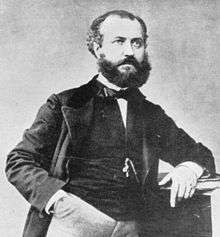La reine de Saba
| Charles Gounod |
|---|
 |
|
Operas
|
La reine de Saba ("The Queen of Sheba") is a grand opera in four or five[1] acts by Charles Gounod to a libretto by Jules Barbier and Michel Carré inspired by Gérard de Nerval's Le voyage en Orient. It was premiered at the Salle Le Peletier by the Paris Opera on February 28, 1862. The magnificent, first production was directed by Eugène Cormon, with costumes designed by Alfred Albert and Paul Lormier, and scenery by Édouard Desplechin (Act I), Charles-Antoine Cambon and Joseph Thierry (Acts II and IV, scene 2), Hugues Martin (Act III), and Joseph Nolau and Auguste-Alfred Rubé (Act IV, scene 1).
Roles

| Role | Voice type | Premiere Cast, 28 February 1862[2] (Conductor: Pierre-Louis Dietsch) |
|---|---|---|
| Balkis, the queen | soprano | Pauline Guéymard-Lauters |
| Bénoni | mezzo-soprano | Hamäckers |
| Sarahil | mezzo-soprano | Tarby |
| Adoniram, sculptor and architect of the first temple | tenor | Louis Guéymard |
| Soliman, the biblical Solomon | bass | Jules-Bernard Belval |
| Amrou | tenor | Raphaël-Auguste Grisy |
| Phanor | baritone | Mécène Marié de l'Isle |
| Méthousaël | bass | Théodore-Jean-Joseph Coulon |
| Sadoc | bass | Frèret |
English version by Henry Farnie
An English reworking of the libretto by Henry Farnie "interwoven [with] certain legends and traditions of freemasonry" was titled Irene. It transposed the action to Istanbul in the time of Suleyman the Magnificent and the building of the Great Mosque and used almost all of Gounod's music.
Highlights
 |
Grand March from La reine de Saba
Performed by the U.S. Marine Band in 1954. |
| Problems playing this file? See media help. | |
The big song from La reine de Saba is the tenor aria 'Inspirez-moi, race divine!', in which the hero invokes the example of the sons of Tubal-Cain (son of Lamech and Zillah, the founder of metalworking) as the molten metal flows into its mould. In its English version 'How vain and weak a thing is man... Lend me your aid, O race divine', this became a war-horse of the concert repertoire, surviving into the 20th century in the recordings of Edward Lloyd and Walter Widdop. It was also recorded by Enrico Caruso, in one of whose versions the English text was re-translated back into French with the exceptionable formula: 'Prêtes-moi ton aide'.
References
- Notes
- ↑ Partition Chant et Piano par Georges Bizet, Choudens fils, Paris nd.; Grove says five acts and other printings of the Chouens score apparently divide the two scenes of the third act.
- ↑ Casaglia, Gherardo (2005).[http://www.amadeusonline.net/almanacco?r=&alm_giorno=28&alm_mese=02&alm_anno=1862&alm_testo=La_reine_de_saba "La reine de saba, 28 February 1862"]. Almanacco Amadeus (Italian).
- Sources
- Steven Huebner. "La reine de Saba". In L. Root, Deane. Grove Music Online. Oxford Music Online. Oxford University Press. (subscription required)
External links
- Reine de Saba. Inspirez-moi, race divine. Vocal score. English & French from the Sibley Music Library Digital Score Collection
- Review of La Reine de Saba (2 March 1862) (in French) in Le Ménestrel (digitized by the Bibliothèque nationale de France)